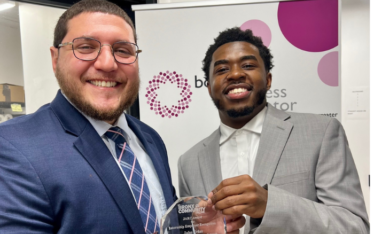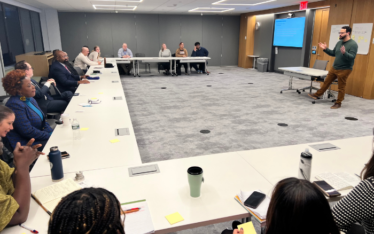On December 3, 2020, the Green Economy Network hosted their second partnership design meeting, focused on the Investigate Phase of the JobsFirstNYC Process. In this meeting, the group explored labor market conditions, market demands, and economic opportunities, and then considered the data in relationship to their on-the-ground experience.
The green economy labor market insights were presented by Christine Chmura, PhD, CEO and Chief Economist of Chmura Economics & Analytics, and Bryan Shelly, PhD, Senior Strategist for Talent & Education, Chmura Economics & Analytics. Using the working sector definition developed by the Green Economy Network leads, Chmura identified a subset of green occupations and green employers and discussed: What’s the impact of the green economy on traditional construction and utility roles? For example, because buildings are being retrofitted, carpenters are doing green jobs — producing green occupations and occupational greening. In contrast, the utilities industry is not all green — some utilities are still very dependent on fossil fuels, but nuclear, solar and biomass are important green subsectors of the utility industry and there is significant growth in green utilities in NYC. Dr. Chmura advised the group to think about tracking over time the occupations, skills and credentials that are in demand in the green industry. Dr. Shelly presented the green occupations within multiple industries, reporting tremendous growth in the New York City region.
The Green Economy Working Sector Definition
The “green economy” is an aspirational destination for the societal project of working towards an economy rooted in environmental, social, racial and economic justice. The term intersects with other terms like resiliency, sustainability, circular economy and climate.
An inclusive green economy is a long-term, interdisciplinary perspective that creates wealth and resilience and serves the interest of future citizens while tackling today’s multidimensional poverty and injustice. It does this by establishing low carbon, resource-conserving, circular systems to safeguard, restore and prioritize investment and access to sustainable natural systems, infrastructure, knowledge, and education necessary for all to actively participate in a just economy that secures family-supporting livelihoods in the sector of sustainable and resilient buildings and communities.
Jeff Vockrodt, Executive Director of Climate Jobs New York spoke about creating opportunity in the green economy. Climate Jobs NY, a coalition of labor unions, was launched following Hurricane Sandy, when it became clear that climate change was disproportionately affecting vulnerable communities. Jeff noted that with labor agreements allowing for the expansion of apprenticeship models, workforce development in the green sector can be strategic about building on effective approaches. Investing in training at this level and creating careers that can grow with the technology is crucial to the success of climate change policies. Overall access and opportunity is crucial to how labor is approaching work in this area, especially in the realm of green jobs. He emphasized that communities worst hit by climate change should benefit from the jobs created to address it.
Santos Rodriguez, Director of Community Affairs & Strategic Initiatives at the Building & Construction Trades Council of Greater New York, a graduate of Construction Skills and born and raised in NYCHA, continued the discussion about promoting access to opportunity through the building trades. Using the Build It Back Hurricane Sandy recovery program as an example, Santos described how commitments to hiring locally and providing workforce training to Sandy-impacted residents improved access to career-track jobs. Building & Construction Trades Council of Greater New York collaborated with multiple workforce training programs, including NEW, Construction Skills, Helmets to Hardhats, Pathways to Apprenticeship (P2A) , and formed the Apprenticeship Readiness Collective (ARC), designed to make entry points into the trades easier.
Speaking about the City’s Community Hiring Initiative and how, if successful, a local hiring mandate could support the Green Economy Network, Amy Peterson, Director of the Mayor’s Office of Workforce Development emphasized the importance of the city’s proposed state legislation for Community Hiring, “ensuring low-income New Yorkers have access to the good jobs and careers that are created through the City’s capital investment and procurement.” Amy expressed the Office of Workforce Development’s interest in working with the Green Economy Network to build this out and hold employers accountable for offering jobs to people who come through workforce training programs.
Finally, we took a deeper dive into JobsFirstNYC’s process of partnership development, reviewing “the five I’s” of the process: Investigate, Imagine, Incubate, Implement, and Integrate. We focused on the Investigate phase,reviewing where we are and the relevant key activities, the roadmap for building a network, and our core values that drive the process — People First, Bold Ideas, Collective Genius, and Informed Objectivity.
The group reconvened on January 7, 2021 to continue to build an inclusive Green Economy for New York City, and plans to meet monthly going forward. If you’re interested in learning more or joining the network, please reach out to Keri Faulhaber at kfaulhaber@jobsfirstnyc.org.





